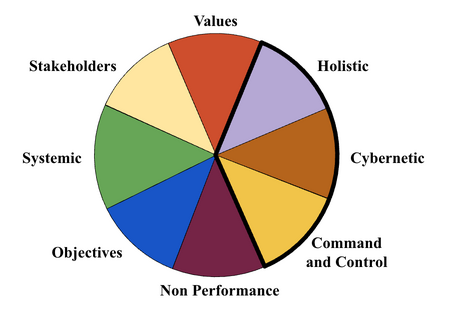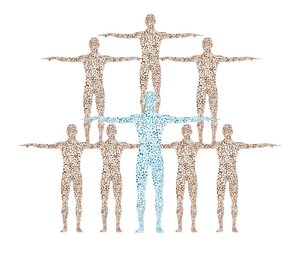Performance Models: Difference between revisions
m (→People First) |
m (→People First) |
||
| Line 40: | Line 40: | ||
|} | |} | ||
=People First= | =People First-Individual Performance= | ||
[[File:Performance_Individual.png|right|300px]] | [[File:Performance_Individual.png|right|300px]] | ||
Revision as of 05:42, 16 September 2025
Introduction
This article introduces different models of organizational performance that have been researched over the past decades and the trend observed toward a better understanding of how individuals function and perform in groups.
When appropriately measured and condensed into results that can be used on a broad range of subjects related to a company’s strategy and day-to-day operations, the measures provide the new foundation for raising organizational performance to new levels.
Performance Models
An organizational performance can be approached through various models, which address aspects of its measurement and control on one hand, and its conceptualization on the other hand.
Until the 1980s, management control research had focused on performance measures with the cybernetic model, an extension of the more popular command and control model until the 1950s. Considering new individual and cultural aspects amid non-financial measures has allowed the holistic model to gradually overcome some limitations of the cybernetic model[1]. Since the 2000s, thanks to capabilities from software platforms, the Internet, and later AI, the Management Control System (MCS) packages have integrated and powered management control systems in an integral system to manage organizations, most often in line with the holistic models. The three grand models are summarized in this table and detailed in separate articles.
Regarding its conceptualization, several approaches have been proposed for categorizing performance depending on the context: research, societal, leadership, organizational development, etc.. For example, the models can be grouped into three categories based on their origins in economics, organizational, and social research[2]. Others have suggested categorizing along the following three categories of objectives, systems, and stakeholders[3] which is the one we adopted here. The value model was analyzed separately from the stakeholders model because it offers a distinct general overall understanding of how individuals and organizations behave. The non-performance model was added, which stands apart and continues to be a powerful model for understanding and managing performance. This grouping enables highlighting different analytical anchor points, limitations, and relations with management control systems.
People First-Individual Performance
As the conceptualization of organizational performance and management control systems have both greatly progressed over the past decades, so has the understanding of people and their management. Although taking more time than in the technology space, thanks to numerous research in social science, we have had the chance to build, break, and challenge many models, techniques, and their limits.
Adaptive profiles emerged from research in the 1950s in the US and started to penetrate small and large organizations worldwide progressively. They measure how people perform in context—not if they perform, but how they perform.
The information is obtained from an assessment technique that allows for the application of statistics and the removal of important biases. The results are profiles that accurately depict the way people think and feel about their behavior, with nuances. The adaptive profile also informs about people's adaptation and engagement, the conditions to avoid underperformance, and the conditions to maximize individual performance. At GRI, we have continued researching and refining the work initiated on these profiles and taken their use to the organizational performance level. The profiles are presented [Adaptive Profile|in other articles, as for instance this one]]</ref>.
Today, markets are familiar with behavioral traits and typologies assessments that have been extensively studied and used, both in recruitment and coaching. Adaptive profiles, however, are based on factors and exhibit different characteristics than those techniques, allowing them to bring precision to the measures and their use in numerous applications related to leadership and organizational development.
Organizational Performance
The adaptive profiles also apply to positions, teams, companies, and even at industry and societal levels, representing the performance required in jobs and those occurring at group levels.
Performance models based on values include a behavioral component that makes them especially useful for practical applications. Behaviors are observable. We can discuss and analyze them more effectively than abstract concepts that can only be inferred from observations. At a company level, this aspect increases the chances of reaching consensus about what those behaviors are and what can be done with them.
At an organizational level, the information from the adaptive profiles is regrouped and compared with that of position and group profiles to measure and analyze performance. More information is presented here on how the adaptive profiles are operationalized at an individual level.
Once the organization has defined the behaviors required in its positions and teams, strategic indicators formalize the intent and manage the gap with people's performance over time. Social indicators follow the adaptation and engagement of employees in the organization. See here how the information is usedto calculate strategic and social indicators.
Notes
- ↑ Henri, J. F. (2004). Performance measurement and Organizational Effectiveness: Bridging the gap. Managerial Finance. Vol. 30, No. 6, pp 93-123.
- ↑ Vibert C. (2004). Theories of macro organizational behavior: a handbook of ideas and explanations.
- ↑ Campbell, J. P. (1977). On the nature of Organizational effectiveness. In P. S. Godman & J. M. Pennings (Eds.), New perspectives on organizational effectiveness. San Francisco: Jossey-Bass. Pp. 13-55.
Zammuto, R. F. (1982). Assessing organizational effectiveness: Systems change, adaptation, and strategy. Albany, N.Y.:Suny-Albany Press.
Quinn, R. E., Rohrbaugh, J. (1983). A Spatial Model of Effectiveness Criteria: Towards a Competing Values Approach to Organizational Analysis. Management Science. Vol. 29, No. 3, pp. 363-377.
Cameron, K. S., Whetten, D. A. (1983). Organizational Effectiveness: One Model or Several? Preface. Orlando: Academic Press.



